Nicholas Edward Brown, 1849-1934
by Brian Stevenson, with John Hutchinson
last updated July, 2021
N.E. Brown was an expert in the study of diatoms, and prepared high-quality microscope slides of diatom frustules during the early 1900s (Figures 1 and 2). He was trained as a botanist, and worked at the Royal Botanic Gardens at Kew from age 24 onward, publishing numerous works on botany.
Brown joined the Quekett Microscopical Club on January 18, 1907. Over the following years, he published several articles on diatoms and other microscopical objects in the QMC's Journal and in other scientific periodicals. Just before his death, Brown produced an 88-page book on Arachnoidiscus diatoms (Figure 4).
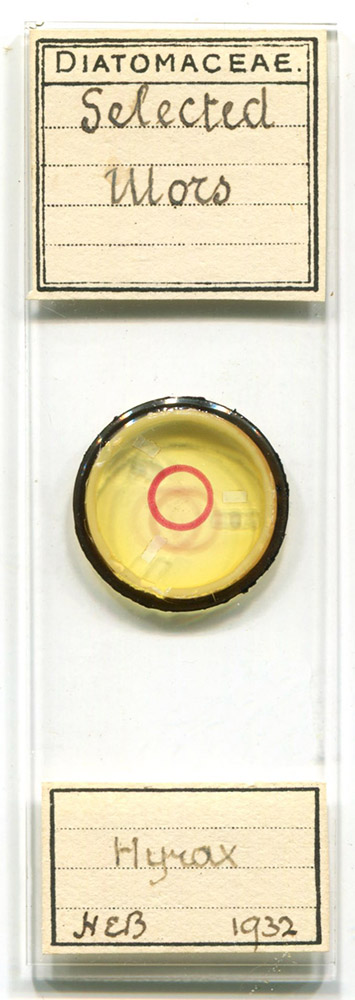
Figure 1.
A microscope slide of selected diatoms from Mors, Denmark, that was prepared by N.E. Brown in 1932 (note his initials on the lower left side of the label). This slide was probably prepared for his own education, and later acquired by a colleague.
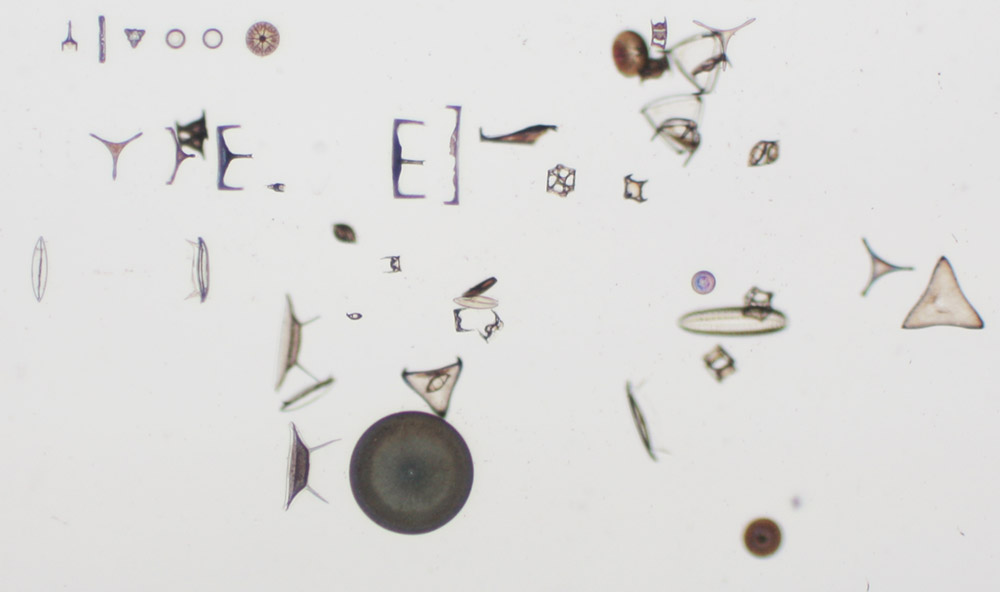
Figure 2.
Selected diatoms from Mors, prepared by Nicholas E. Brown in 1932 (see Figure 1). Presumably, the frustules were originally laid in a linear array, and have since drifted apart in all three dimensions.
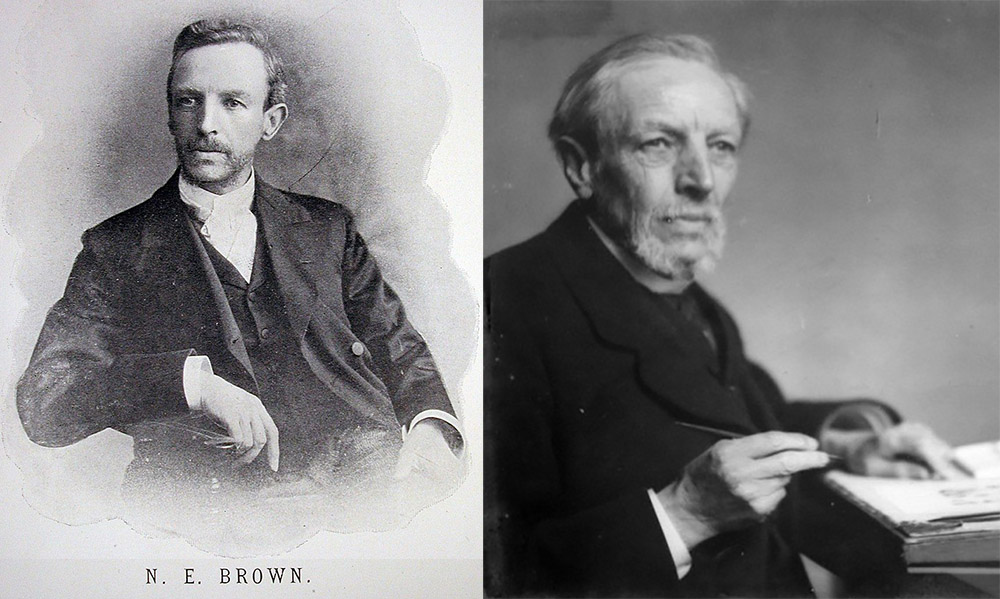
Figure 3.
Nicholas Edward Brown, in mid-life (left) and toward the end of his life (right).
John Hutchinson (1884-1972, Keeper of Museums at Kew from 1936 to 1948) studied under Brown, and wrote the following biography after Brown's death:
Dr. N.E. Brown was born at Redhill, Surrey, on July 11th, 1849. He died peacefully on November 25th, 1934, at his residence in The Avenue, Kew Gardens, after a few months' illness, retaining all his faculties to the last. He was buried at Richmond Cemetery on November 29th in the presence of many of his former colleagues and friends.
Brown was educated at the Grammar School at Reigate, and on leaving was employed by Mr. William Wilson Saunders, F.R.F.L.S., to act as Curator of his museum in the same town. At that time Mr. Saunders was one of the leading naturalists in England, and a most liberal amateur horticulturist. He produced and edited the Refugium Botanicum, or "Figures and Descriptions, from living specimens, of Little Known or New Plants of Botanical Interest". This work ran into five volumes, from 1869 to 1873, and was devoted chiefly to succulent plants generally, bulbous plants of various families, Orchids, Aroids, Bromeliads, Geraniaceae, etc., the very plants in which Brown ever afterwards retained a keen interest and on which he was regarded as the chief authority. These volumes appeared during Brown's curatorship of Mr. Saunders' museum, and it was natural that so promising a botanist as he must have then shown himself to be should migrate to Kew, for Mr. Saunders had enlisted the help of Mr. J.G. Baker and Mr. W.H. Fitch, who were responsible for the descriptions, and for the figures and dissections respectively, whilst the celebrated orchid specialist of the day, Professor H. G. Reichenbach, of Hamburg, contributed the accounts of the orchids. Thus Brown had the great advantage, at the threshold of his career, of being closely associated with the leading botanists of the time. That he retained a lively interest in these five volumes of his employer seems clear, for his pencil emendations are numerous on the Kew copy, which no doubt explains why Reichenbach used to speak of him as his "lynx-eyed little friend".
In February 1873 Brown, at the age of 24, was appointed Assistant in the Herbarium at Kew, and, although of poor physique and often in indifferent health, he has outlived all his colleagues of that time. In 1874 he commenced lecturing on geographical botany, which brought him into contact with successive generations of student-gardeners, and it is in this connection that many such remember him best. His portrait appeared in the Kew Guild Journal for 1904. Horticulture, as well as botany, owes a good deal to Brown. From 1876 to 1886 he compiled the annual lists of new plants in Hogg's Gardeners' Year Book, and when that publication ceased he prepared similar lists for the Kew Bulletin, a task later handed on to his colleague, Mr. S.A. Skan. He was concerned with the compilation of that useful work, Johnson's Gardeners' Dictionary, and during nearly the whole of his life was a valued contributor to the Gardeners' Chronicle.
Brown's contributions to botany were many and varied. In 1886 he completed the last volume (vol. 12) of Syme's English Botany, some of the plates being from his own brush, and he published a supplement to vols. 1-4 in 1892. After this his official duties diverted his energies into tropical botany. He became intensely interested in the floras of Tropical and South Africa, especially the latter, and he possessed an unrivalled knowledge of the geography of Africa. He checked the whole of the records localities after the resuscitation of the Flora of Tropical Africa and the Flora Capensis under the editorship of Sir William Thiselton-Dyer, his help being gratefully acknowledged in the preface to each volume.
In 1892 he contributed his first description to the Decades Kewenses and to the Diagnoses Africanae, under the titles of which he has published descriptions of very many new species. Most the papers in the early volumes of the Kew Bulletin were unsigned, but Brown's name appeared in 1894 with an account of "Tuberous Labiatae". From 1896 to the time of his retirement in 1914 Brown was occupied mainly with the flora of Africa. Besides checking the geographical records mentioned above, he elaborated some of the most difficult families. He did a portion of the Orchidaceae for vol. 7 (1898) of the Flora of Tropical Africa, and for the remainder of that work the following families, most of them entailing much laborious and careful dissection: Pontederiaceae, Xyridaceae, Typhaceae, Araceae, Eriocaulaceae Mayacaceae, Asclepiadaceae, Gentianaceae (with J.G. Baker), and for vol. 6 the troublesome genus Euphorbia, his account of this occupying 158 pages. With reference to this the editor says in the preface "Mr. N.E. Brown, A.L.S., who finds a peculiar fascination in the study of succulent plants, the difficulties of which most botanists find deterrent, undertook the genus Euphorbia". His most important separate paper on the African flora was his "List of Plants collected in Ngamiland and Northern Kalahari Desert by Major E.J. Lugard, D.S.O." (K.B. 1909, 89-146), most of his determinations having stood the test of time and revision.
In 1915 he published in the Kew Bulletin a valuable monograph of all the known species of Sansevieria, and the year before that "Notes on the genera Cordyline, Dracaena, Pleomele, Sansevieria and Taetsia".
Without Brown's help the Flora Capensis might even now be unfinished, for he contributed very largely to its pages. In vol. 7 he described the same monocotyledonous families as he had done for the Tropical Flora; for vol. 5, pt. 1, he did part of the Labiatae; for vol. 4, pt. 1, the Asclepiadaceae (occupying 518 pages), and the smaller genera of Ericaceae (103 pages); and in addition to complete the account of Erica by Guthrie and Bolus, the former dying during its preparation, and the latter having to give up the work owing to indifferent health. At the close of his official connection with Kew, Brown worked out the genus Euphorbia (155 pages) and the family Urticaceae for the same Flora. His contributions to our knowledge of all these intricate families may be described as models of critical and thorough work.
Brown was also entrusted with the enumeration of the very important collection of plants made on Mt. Roraima in British Guiana by McConnell and Quelch (Trans. Linn. Soc. ser. 2, 6, 18-107, with 14 plates, the analyses by N.E. Brown), and after his retirement worked out some South American collections for the New York Botanical Garden.
Of late years Brown made a critical study of the large genus Mesembryanthemum, and has divided it into a very great and perhaps excessive number of smaller genera, published mainly in the Gardeners' Chronicle. He also collaborated with A. Tischer and M.C. Karsten in producing a book entitled Mesembryanthema, with descriptions in English, German and Dutch, and edited by E.J. Labarre (L. Reeve & Co., 1931). He grew many of these plants in his small greenhouse, and it is satisfactory to record that they have now been added to the Kew collection. He assisted Dr. Burtt Davy with portions of the Flora of the Transvaal, and recently worked a good deal at the South African Iridaceae, including a critical review of those of Thunberg's herbarium (Journ. Linn. Soc. Bot. 48, 15-55: 1928). He was always keen to see Thunberg's specimens on which so many South African species are based, and he published notes on Aloe and Mesembryanthemum as represented in that herbarium.
Besides his botanical work Brown was a keen microscopist, and was a member of the Quekett Microscopical Club. In the Club's journal for 1914 he published "Some Notes on the Structure of Diatoms", and in 1920 in the English Mechanic a paper on "Some New and Old Antarctic Diatoms", whilst only last year, when 84 years of age, he brought out a small book containing an account of Arachnoidiscus, a genus of diatoms, consisting of 88 pages of descriptive matter and 7 plates (W. Watson & Sons, Ltd., London).
Brown was promoted to be Assistant Keeper of the Herbarium in 1909. He was elected an Associate of the Linnean Society in 1879, and in 1921 was awarded the Captain Scott Memorial Medal by the South African Biological Society in recognition of his work on the South African Flora. In 1932 the University of the Witwatersrand, Johannesburg, conferred on him the Honorary degree of Doctor of Science, the Director performing the ceremony at the herbarium in the presence of the staff (K.B. 1932, 155). A little before his death he was actually engaged on a monograph of the genus Conophytum, for which he had prepared a number of beautifully executed colour plates and dissections, for he was a very good botanical artist and could use colour with delicate effect. In his younger days he drew many of the plates for Mr. C.B. Clarke's Illustrations of Cyperaceae.
Dr. Brown's taxonomic work was of a very high standard, and he paid great attention to small details. As the herbarium sheets show everywhere he was very critical, indeed almost hyper-critical, in specific determinations. If anything were wrong with a drawing, a description or a determination in the herbarium, Brown would be sure to find it out. He could "spot" the family and genus of most plants, and was always very helpful to younger colleagues like the writer, who never appealed to him in vain. Although something of a recluse and chained to his science, whereby he accomplished much more than the average worker, Brown had a strong sense of humour and loved to "crack a joke". Even his pencil notes on the herbarium sheets show this. One, which he was fond of showing to visitors, is attached to a specimen of Lecythis from Demerara (Jenman 4155) named by J.G. Baker. On this sheet C.B. Clarke had written "Does this fruit really belong?" to which Brown had replied "This 'fruit' is a spider!" And so it is!
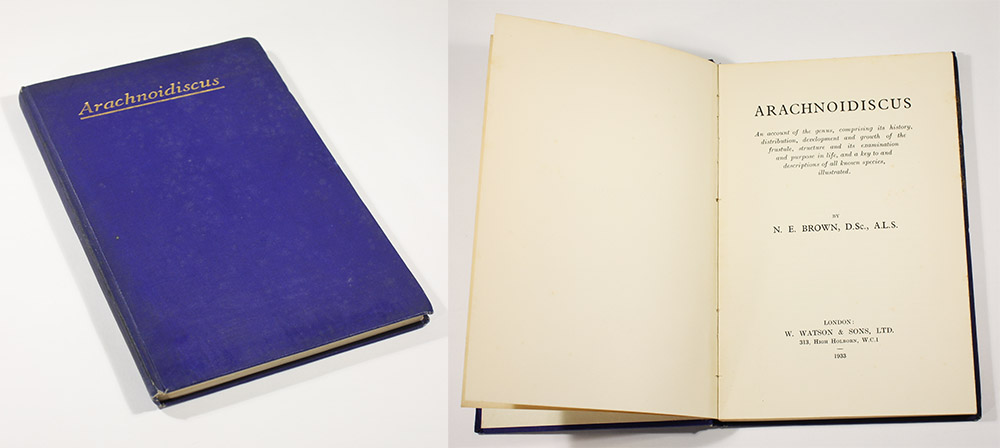
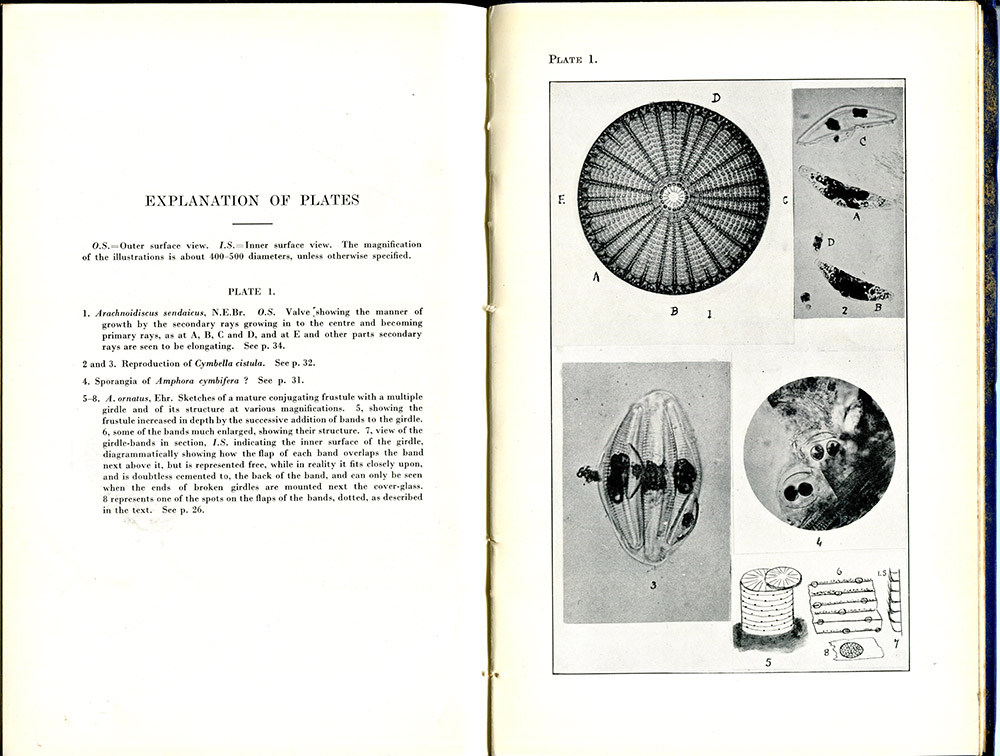
Figure 4.
N.E. Brown published "Arachnoidiscus" in 1933.
Resources
Brown, N.E. (1911) Some notes on seeds as microscopic objects, Journal of the Quekett Microscopical Club, Series 2, Vol. 11, pages 307-312
Brown, N.E. (1912) Rhabdonema minutum, Journal of the Quekett Microscopical Club, Series 2, Vol. 11, pages 517-518
Brown, N.E. (1914) Some notes on the structure of diatoms, Journal of the Quekett Microscopical Club, Series 2, Vol. 12, pages 317-338
Brown, N.E. (1920) New and old diatoms from the Antarctic regions, The English Mechanic and World of Science, Vol. 111, pages 219-220
Brown, N.E. (1928) The blow fly's tongue as it should be seen, Watson's Microscope Record, Issue 15, pages 22-23
Brown, N.E. (1930) The one-sixth objective, Watson's Microscope Record, Issue 19, pages 15-18
Brown, N.E. (1931) Some interesting test objects, Watson's Microscope Record, Issue 24, pages 10-14
Brown, N.E. (1931 and 1931) The structure of diatoms, Watson's Microscope Record, Issues 27 and 28, pages 12-14 and 10-11, respectively
Brown, N.E. (1933) Arachnoidiscus. An account of the genus, comprising its history, distribution, development and growth of the frustule, structure and its examination and purpose in life, and a key to and descriptions of all known species, illustrated, Watson and Sons, London
Hutchinson, John (1935) Nicholas Edward Brown, Bulletin of Miscellaneous Information (Royal Botanic Gardens, Kew), Vol. 1, pages 57-64




